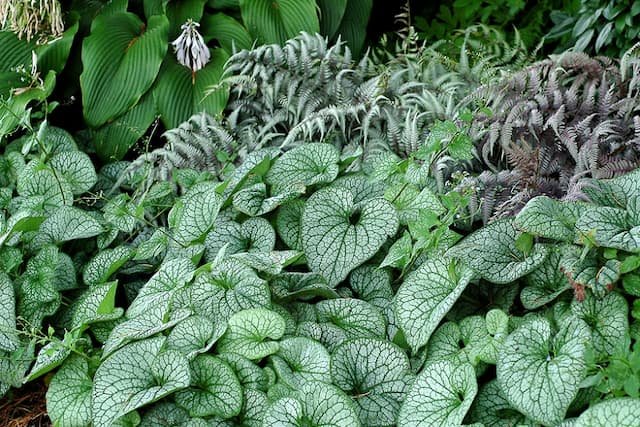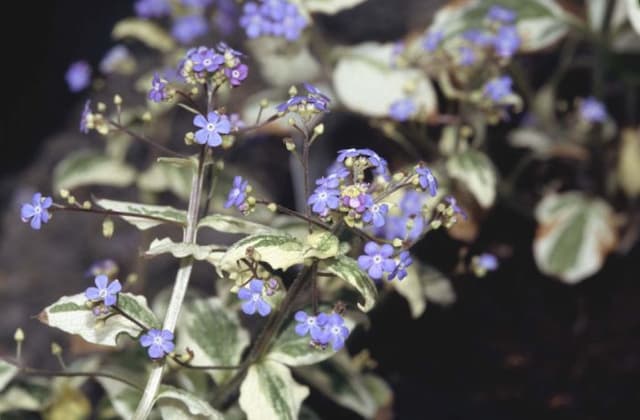Red Lungwort Pulmonaria rubra 'David Ward' (v)

ABOUT
Pulmonaria rubra 'David Ward', commonly known as red lungwort, carries a stunning visual appeal with its distinctive foliage and flowers. This variety in particular is cherished for its decorative leaves and blossoms that emerge in the early parts of the growing season. The leaves are remarkably eye-catching, bearing a green base adorned with creamy-white variegation along the margins, giving them a striking contrast. As the seasons progress, these leaves develop an ovate shape with a somewhat rough, hairy texture which adds a further tactile element to its appearance. The charm of the red lungwort is significantly heightened by its flowers. The blooms of 'David Ward' present a soft, coral-red hue, delicately poised on clusters atop slender, upright stems. The trumpet-shaped flowers are a magnet for local bees and butterflies, which find the nectar irresistible during the flowering period. The visual juxtaposition of creamy-edged leaves against the warm red blossoms creates a vibrant but harmonious display, thereby enhancing the allure of gardens throughout the blooming time.
About this plant
 Names
NamesFamily
Boraginaceae
Synonyms
Red Lungwort, 'David Ward' Lungwort
Common names
Pulmonaria rubra 'David Ward'
 Characteristics
CharacteristicsLife cycle
Perennials
Foliage type
Semi-evergreen
Color of leaves
Mixed
Flower color
Red
Height
1 foot (30 cm)
Spread
1 foot (30 cm)
Plant type
Herb
Hardiness zones
4
Native area
Europe
Benefits
 General Benefits
General Benefits- Attracts pollinators: Pulmonaria rubra 'David Ward' provides nectar and pollen for bees and other pollinating insects.
- Low maintenance: This plant has minimal care requirements, making it a great choice for novice gardeners or those with limited time.
- Shade tolerance: It thrives in shaded areas where other plants might not grow, thus offering gardeners a beautiful option for dark corners.
- Early blooming: Since it blooms early in spring, it can provide color in the garden at a time when many other plants have not yet started to flower.
- Variegated foliage: The plant’s distinct variegated leaves add visual interest to the garden throughout the growing season, even when it's not in bloom.
- Ground cover: Its dense growth habit helps suppress weeds, reducing the need for regular weeding and providing an attractive carpet of foliage.
- Drought resistance: Once established, Pulmonaria rubra 'David Ward' can tolerate periods of dryness, making it suitable for xeriscaping or gardens prone to drought.
- Wildlife friendly: The plant can provide shelter and habitat for small wildlife, such as beneficial insects.
 Medical Properties
Medical PropertiesThis plant is not used for medical purposes.
 Air-purifying Qualities
Air-purifying QualitiesThis plant is not specifically known for air purifying qualities.
 Other Uses
Other Uses- Pulmonaria rubra 'David Ward', commonly known as red lungwort, can be used as a natural dye. The leaves may produce varying shades of green or yellow when used in fabric dyeing.
- In a wildlife garden, red lungwort provides early spring nectar for bees and other pollinators when few other floral resources are available.
- The patterned leaves of red lungwort can be used as a botanical print material in art projects, such as creating natural patterns on paper or fabric.
- This plant serves as an educational tool in botany classes to demonstrate variegation in leaves, as well as the change in flower color due to pH variations in plant physiology studies.
- Red lungwort can be planted in containers with other shade-loving plants to create attractive foliage contrasts and textural variation in a shaded patio or balcony garden.
- The plant's root system is useful for erosion control on shaded slopes where other plants might not thrive as well due to low light conditions.
- Red lungwort can be used as a ground cover to suppress weeds in a shaded garden area, using its dense foliage as a living mulch.
- In a sensory garden, the velvety leaves of red lungwort can be included to add a tactile element for visitors to touch and explore.
- During a frost, the leaves of red lungwort can sometimes take on a crystalline appearance, adding unexpected beauty to a winter garden.
- The contrasting colors of the flowers and foliage can be a source of inspiration for artists and designers looking to create naturalistic color palettes.
Interesting Facts
 Feng Shui
Feng ShuiThe Lungwort is not used in Feng Shui practice.
 Zodiac Sign Compitability
Zodiac Sign CompitabilityThe Lungwort is not used in astrology practice.
 Plant Symbolism
Plant Symbolism- Healing: Pulmonaria rubra 'David Ward', commonly known as Red Lungwort, has been traditionally used in herbal medicine to treat lung diseases, symbolizing healing and the alleviation of illness.
- Growth: The emergence of its flowers early in spring signifies new beginnings and growth, reminding us of the constant cycle of renewal in nature.
- Protection: The spotted pattern on the leaves of lungwort has often been associated with the Virgin Mary's milk in Christian tradition, suggesting a symbol of divine protection and care.
- Resilience: As lungwort can thrive in shaded environments, it is a symbol of resilience and the ability to prosper even in less than ideal circumstances.
 Water
WaterRed Lungwort should be watered regularly to keep the soil consistently moist but not waterlogged. During the growing season, especially in the spring and summer, it may need to be watered about once a week. Ensure that you provide about one to two gallons per watering session, depending on the size of the plant and the climate. In hot, dry spells you may need to water more frequently to prevent the soil from drying out completely. During the winter, reduce watering as the plant requires less moisture when it's not in active growth.
 Light
LightRed Lungwort thrives best in partial shade to full shade conditions, as too much direct sunlight can scorch its leaves. The ideal spot for this plant would be in a garden area that receives filtered sunlight or dappled shade, perhaps under the canopy of taller trees or on the north side of a building where it can be protected from the intense afternoon sun.
 Temperature
TemperatureRed Lungwort prefers temperatures that typically range from 50°F to 75°F. It can survive minimum temperatures down to around 30°F, but it is not tolerant of extreme cold and should be protected from hard frosts. Ideal temperature conditions are typically achieved in its natural woodland setting, where it is sheltered from the hottest temperatures by shade and retains warmth in the soil during cooler periods.
 Pruning
PruningRed Lungwort should be pruned to remove any damaged or dead foliage and to encourage denser growth. Pruning is best done after the plant has finished flowering, typically in late spring or early summer. Cut back the foliage to stimulate fresh growth, doing so annually or as needed to maintain plant health and aesthetic appeal.
 Cleaning
CleaningAs needed
 Soil
SoilRed Lungwort (also known as Pulmonaria rubra 'David Ward') thrives best in a soil mix that is rich in organic matter, with good drainage to prevent waterlogging. A mix of two parts garden soil, one part peat moss or well-decomposed compost, and one part perlite or vermiculite is ideal. The pH should be slightly acidic to neutral, ranging between 6.0 to 7.0.
 Repotting
RepottingRed Lungwort should be repotted every 2-3 years to refresh the soil and accommodate root growth. The best time to repot is during the spring, just before the growing season begins.
 Humidity & Misting
Humidity & MistingRed Lungwort prefers a humid environment but adapts to average room humidity. For best results, aim for a relative humidity level of about 40-50%.
 Suitable locations
Suitable locationsIndoor
Keep Red Lungwort in bright, indirect light and moist soil.
Outdoor
Plant Red Lungwort in partial shade and keep soil consistently moist.
Hardiness zone
4-8 USDA
 Life cycle
Life cyclePulmonaria rubra 'David Ward', commonly known as Red Lungwort 'David Ward', begins its life cycle as a seed that germinates in moist, well-drained soil, typically in partial to full shade. Upon sprouting, it enters the vegetative stage, developing a rosette of variegated leaves with green centers and white margins that are hairy and rough in texture. As it matures, it reaches the flowering stage, typically in early to mid-spring, producing clusters of reddish-pink flowers that attract pollinators and eventually transition to blue with age. Following pollination, it sets seed, allowing for the dispersal and potential germination of new plants. After flowering, it continues to grow vegetatively, enlarging its clump with offsets, and may go semi-dormant during very hot summers or in reaction to drought, though it is generally evergreen. Over time, the plant can be divided and propagated to manage its size and vigor or to create new plants.
 Propogation
PropogationPropogation time
Spring-Early Summer
Pulmonaria rubra 'David Ward', commonly known as red lungwort, is best propagated by division. This method should be performed in the spring or early fall. To propagate by division, carefully dig up an established plant and gently separate it into smaller sections, ensuring that each new section has a good portion of the root system intact. Replant the divisions at the same depth they were growing previously, spacing them about 12 inches (30 centimeters) apart to allow enough room for growth. Water the new plantings thoroughly to help establish them. This simple and effective technique allows the gardener to create new red lungwort plants that will mature and bloom in subsequent seasons.









